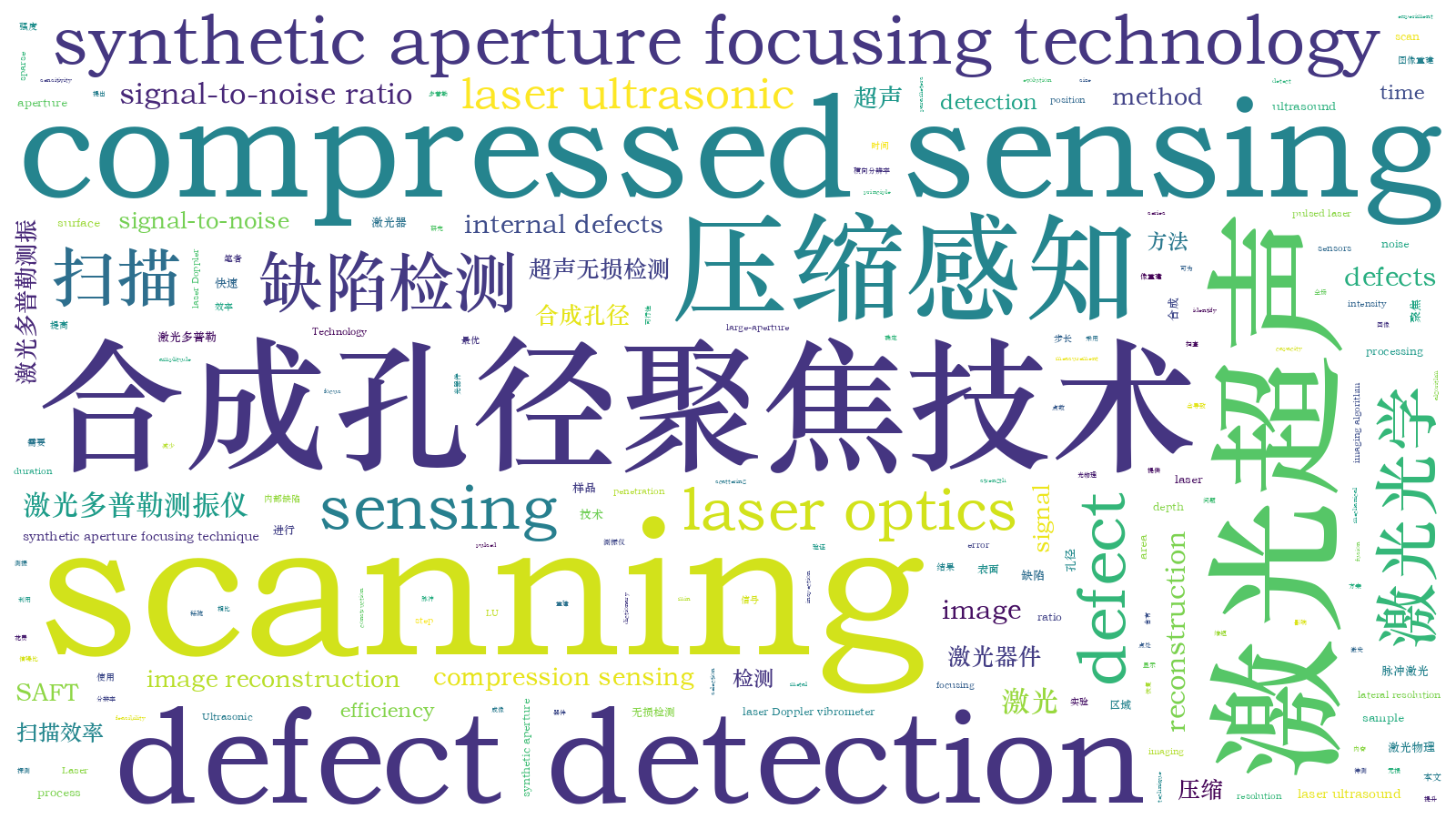基于压缩感知的快速激光超声合成孔径聚焦技术
In the industrial sector, the processing or extended utilization of various metal workpieces can generate assorted surface and internal defects. These imperfections can compromise the mechanical strength of the workpiece, thereby reducing its operational lifespan. Given its high penetration capacity and sensitivity, ultrasonic inspection has gained widespread usage in defect detection. In recent years, there has been an increased focus on imaging technologies in the evolution of defect detection methods. Among these, the synthetic aperture focusing technique (SAFT) is a viable imaging algorithm for ultrasonic inspections. It replaces large-aperture sensors with a series of individual small-aperture sensors, thereby enhancing the lateral resolution. The laser ultrasound synthetic aperture focusing technology (LU-SAFT) is a fusion of SAFT and laser ultrasound technologies, reaping the benefits of both. However, conventional LU-SAFT typically requires small-step scanning of the sample surface to be tested to enhance lateral resolution. This methodology, while effective, results in a prolonged overall detection time, thereby reducing the efficiency of the detection process. This major limitation hinders the practicality of traditional LU-SAFT. In our study, we aim to enhance the scanning efficiency and reduce the scanning duration of the conventional LU-SAFT.
This study presented a LU-SAFT method based on compressed sensing to enhance the scanning efficiency of conventional LU-SAFT. Initially, compressed sensing was employed to retrieve the maximum intensity of the A-scanning signal at the scanning points of the entire field from the maximum intensity of the A-scanning signal at sparse scanning points. Following that, the optimal scanning area of the sample surface was determined. Subsequently, scanning was conducted in this optimal area. Finally, SAFT image reconstruction was conducted for the defect. In the experiment, a pulsed laser was utilized to incite ultrasound on the surface of a defective sample. A laser Doppler vibrometer was employed to detect the ultrasound, and the LU-SAFT method rooted in compressed sensing was applied to identify the defects in the sample. This process served to confirm the feasibility of the proposed method.
The LU-SAFT method is used to scan the detection area based on compressed sensing. A total of 100 points are scanned, taking 0.63 min. Conversely, scanning with the conventional LU-SAFT method, which employs a scan step of 0.05 mm, requires 500 points and takes 3.15 min. When compared to the traditional LU-SAFT scanning process, the LU-SAFT method based on compressed sensing reduces the number of scanning points by 80% and decreases the scanning time by approximately 2.52 min. In the LU-SAFT defect reconstruction image based on compression sensing (Fig. 8), the top of the defect is located at a depth of -3.76 mm, deviating from the actual measurement by 0.01 mm, an error of 0.3%. The lateral position is 0.18 mm, deviating from the actual value by 0.18 mm, with an error of 1.4%. The signal-to-noise ratio corresponds to 71.31 dB. Meanwhile, in the conventional LU-SAFT defect reconstruction image (Fig.8), the top scattering of the defect is positioned at a depth of -3.76 mm and its lateral position remains at 0.18 mm. However, the signal-to-noise ratio is lower at 50.35 dB. Comparing the LU-SAFT defect reconstruction image based on compression sensing with the conventional LU-SAFT defect reconstruction image, it is evident that the depth and lateral positions of the defects in both images are nearly identical to the actual defects. Furthermore, the signal amplitude map of the LU-SAFT defect reconstruction image based on compression sensing (Fig.8) showcases a higher signal-to-noise ratio and requires fewer scanned points than the conventional LU-SAFT defect reconstruction image (Fig.8). From these results, it is clear that the LU-SAFT method based on compression sensing significantly reduces the scanning time of traditional LU-SAFT, thereby enhancing scanning efficiency.
In this study, the principle and processing flow of LU-SAFT based on compressed sensing are analyzed initially. Subsequently, the value of sparse scan points, construction of a dictionary, size of the optimal scanning area, and selection of suitable values are discussed. Finally, experiments are conducted using the parameters obtained from this analysis. The experimental results demonstrate that the LU-SAFT defect reconstruction image based on compressed sensing can enhance scanning efficiency and reduce the scanning time. These findings can offer fresh perspectives and solutions to address the time-consuming scanning process inherent in conventional LU-SAFT.
何志同, 应恺宁, 戴鹭楠, 倪辰荫. 基于压缩感知的快速激光超声合成孔径聚焦技术[J]. 中国激光, 2024, 51(2): 0201004. Zhitong He, Kaining Ying, Lunan Dai, Chenyin Ni. Fast Laser Ultrasonic Synthetic Aperture Focusing Technology Based on Compressed Sensing[J]. Chinese Journal of Lasers, 2024, 51(2): 0201004.







